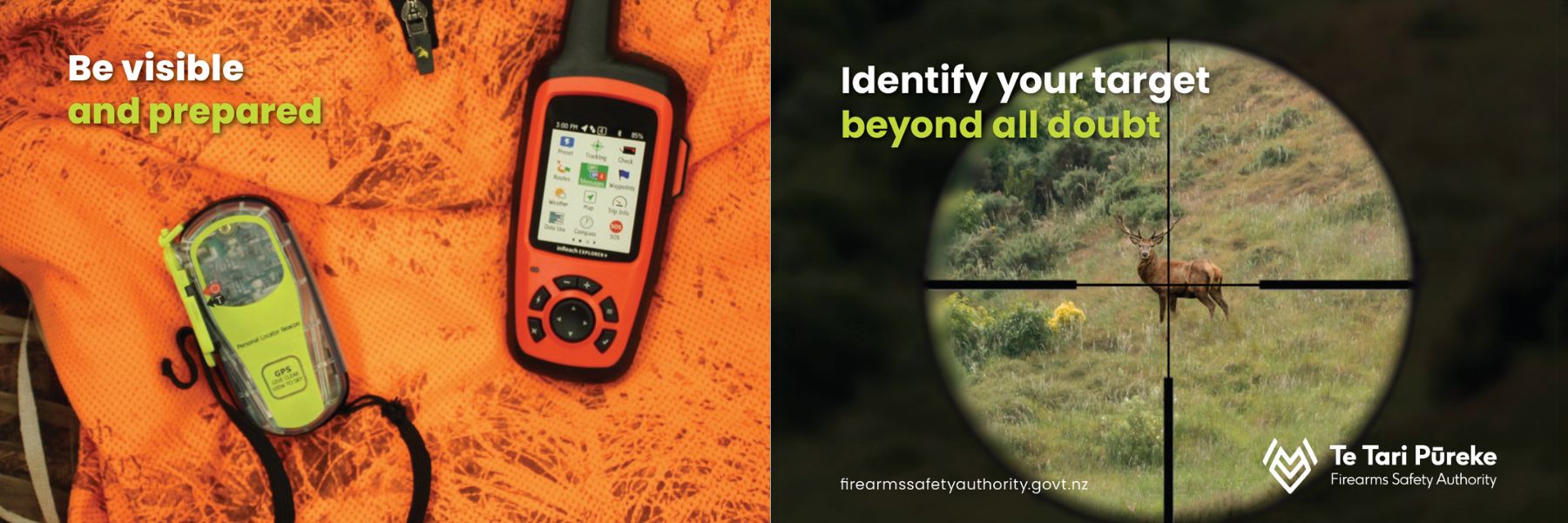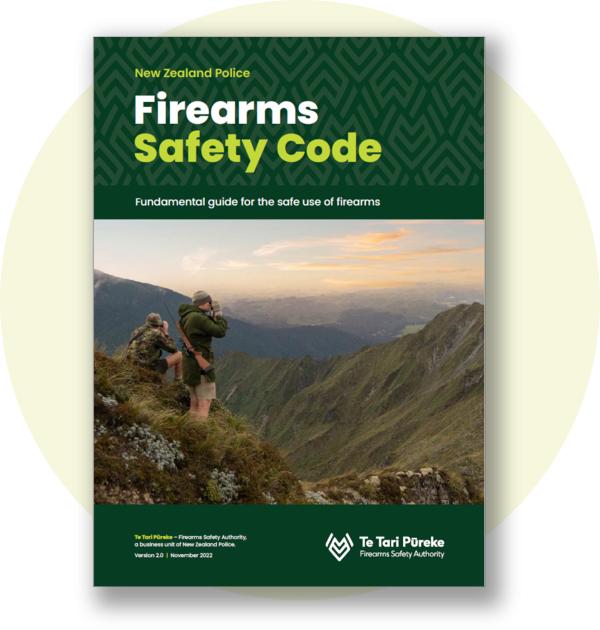Rule 3 and rule 6 of the Seven Safety Rules have been updated.
Spot the difference. Make sure you’re aware of the changes.
27 March 2023
View changes here: https://www.firearmssafetyauthority.govt.nz/firearms-safety/7-safety-rules
New rules apply this roar as changes have been made to the Arms Code alongside new transport safety regulations which were put in place February 2022. NZDA advises hunters to make sure they’re well versed on these key changes.
There have been changes to Rule 3 and Rule 6 of the 7 Basic Firearms Safety Rules. These rule changes affect all hunters transporting firearms and ammo across country to reach their chosen hunting grounds.
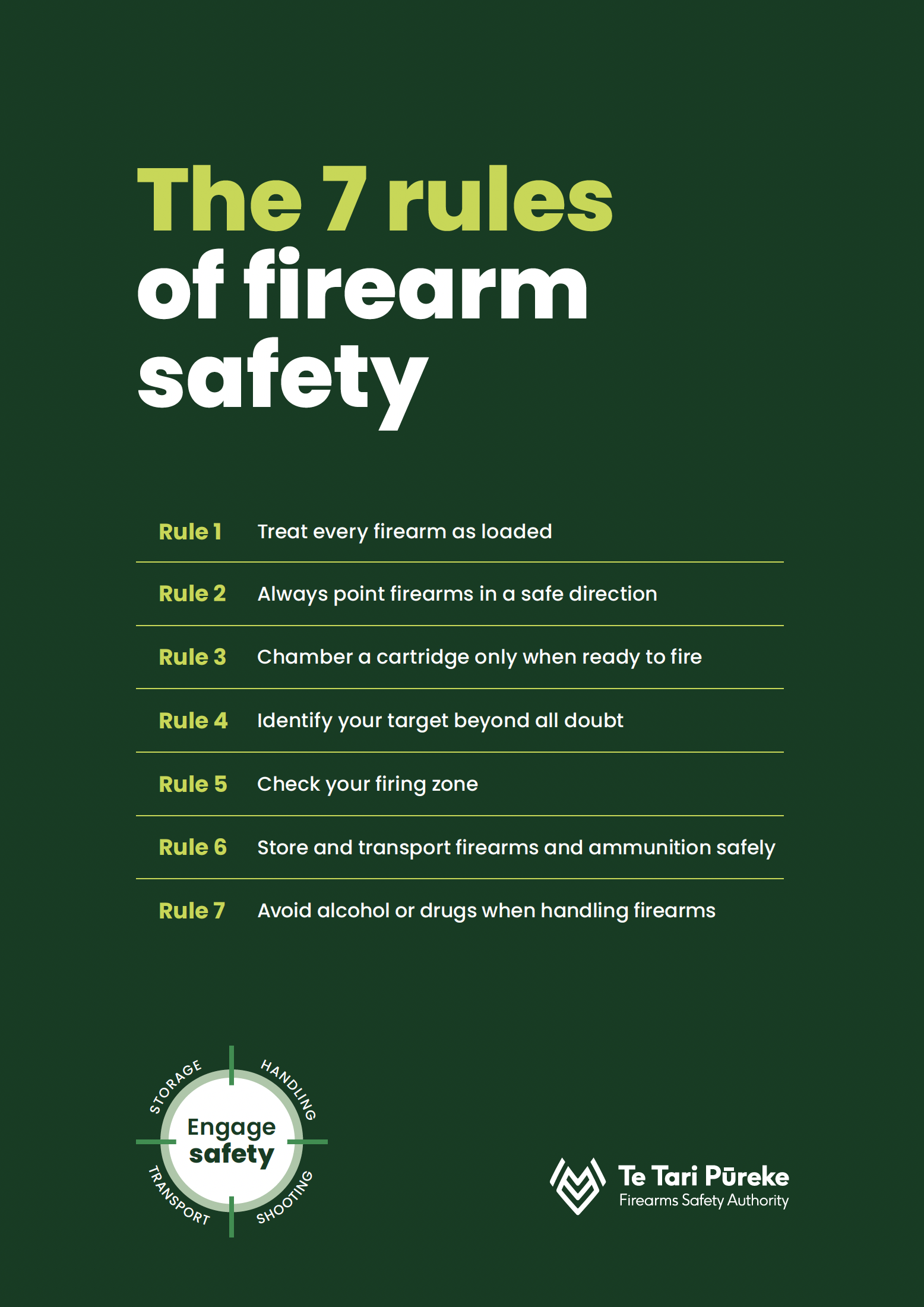
Rule 1: Treat every firearm as loaded
- No matter how sure you are that your firearm is unloaded, handle it as carefully as you would a loaded firearm and keep your finger off the trigger.
- Always point a firearm in a safe direction. Never point a firearm at yourself or any other person!
- Always check every firearm yourself.
- Do not take anyone else’s word that a firearm is unloaded.
- Follow the correct procedure to ensure the firearm is unloaded.
- If you do not know how to unload a particular firearm, leave it alone and find someone who does.
- When passing or accepting an unloaded firearm, always ensure the muzzle is pointed in a safe direction.
- If the firearm belongs to someone else, ask them to show you it is unloaded before taking possession of it.
- Never handle a firearm from the muzzle end.
- Never lean firearms against vehicles or in any place where they could slide or fall and negligently discharge.
Rule 2: Always point firearms in a safe direction
- Always be careful about muzzle direction and NEVER point a firearm at yourself or another person.
- Keep focused when handling firearms – no daydreaming.
- Never lean your firearm against a vehicle or in any place where it could slide or fall and negligently discharge.
- Be particularly careful when placing firearms in, or removing them from, vehicles, boats and storage.
- Always be aware of the possibility of unintentional discharge when changing the state of your firearm.
- A safe direction is one that you judge the safest depending on where you are.
Be aware there is an increased risk of unintentional discharge when:
- closing or opening the bolt or action;
- releasing the safety catch;
- de-cocking the action;
- the trigger is pressed despite the safety catch being ‘on’ (‘safe’);
- slipping, tripping or falling when carrying a firearm; or
- removing a firearm from, or returning a firearm to, a motor vehicle or storage.
Rule 3: Chamber a cartridge only when ready to fire
- Chamber a cartridge only when expecting to encounter game animals or when you are about to discharge the firearm, for example, on a shooting range.
- In some hunting situations, for example when bush hunting or sitting in a duck blind, a cartridge may be chambered when game animals are expected to be encountered. In many other hunting situations, including hunting in open country, a cartridge shouldn’t be chambered until you are ready to shoot.
- Minimise risk by having a cartridge chambered only when necessary.
- If you are unsure of the state of your firearm, carry out Safety Precautions to ensure the firearm is unloaded.
- If the situation changes, such as leaving the immediate hunting area, then either return your firearm to the LOAD state or fully UNLOAD it.
- In a hunting group, only the person in the front should have their firearm in the LOAD state.
- If the game gets away after you move the safety to ‘off’ (‘fire’) (the INSTANT state), you must return the safety to ‘on’ (‘safe’) (the ACTION state) immediately.
Semi-automatic shotguns and rifles
- When you have seen or expect to flush game at any moment, load the firearm and place the previously tested safety catch on ‘safe’.
- If you release the safety catch but decide not to shoot, re-apply the safety catch.
- Whenever a round is in the chamber you must be absolutely sure the muzzle is pointing in a safe direction.
- Test the safety catch before loading any ammunition into the chamber.
- If you have any doubt about the safety catch don’t trust it and have it checked by a gunsmith.
Note
Some safety catches have three positions – ‘on’, ‘off’ and a middle position that allows the bolt to operate but still blocks the trigger mechanism. Always familiarise yourself with a firearms safety before using it with ammunition. Like all mechanical devices, safety catches are subject to wear and tear and should never be relied on by themselves to replace firearms safe handling rules and practice such as keeping the muzzle in a safe direction.
Rule 4: Identify your target beyond all doubt
- You must positively identify your target beyond all doubt before you fire.
- If in doubt, don't shoot!
- Do not use a rifle’s optical sights to scan the area or to identify a possible target. This is breaking Rule 2 – always point your firearm
- in a safe direction.
- Keep your finger away from the trigger and your muzzle pointed in a safe direction until you are 100% certain of your target and that it is safe to fire.
- Always identify all of the animal before firing. See the whole animal, analyse it, ensure it’s not a hunter carrying an animal.
- Never fire at movement only. Moving bushes or trees might be a person.
- Never fire at colour only. For example, some clothing colours worn by hunters can be similar to deer hide.
- Never fire at sound only. Hunters may be imitating an animal call, such as a deer roaring.
- Never fire at shape only. Your brain may mislead you into thinking the object you are seeing is a game animal.
- Ask yourself, “Where are my hunting companions? Could there be another hunter out there?”
- If supervising an unlicensed shooter, the supervisor and shooter must both positively identify the target beyond all doubt.
Target identification issues
When you are tired or excited, emotions may override rational thinking (buck or stag fever). Perception can play tricks and you may ‘see’ what you expect to see. Objects – often people – can look like game animals.
There could be other hunters nearby. They may make noises imitating the calls of game. Even the definite sighting of skin and antlers is not enough – hunters have been shot while carrying a deer. BEFORE you shoot ask yourself: “Is this a person?” This will focus your mind toward expecting to see a person, rather than expecting to see an animal.
Stand out to stay safe
Bright coloured clothing and gear can help you to be seen, especially in dim or fading light. Keep in mind that no one colour will be easily seen at all times of the day and in all surroundings. Wear a colour that stands out from the background you are shooting and is different from any game animals in that area. While this can minimise your risk of being shot, it will only do so if other hunters properly identify their targets.
Remember – it is ALWAYS the responsibility of the shooter to identify clearly the target.
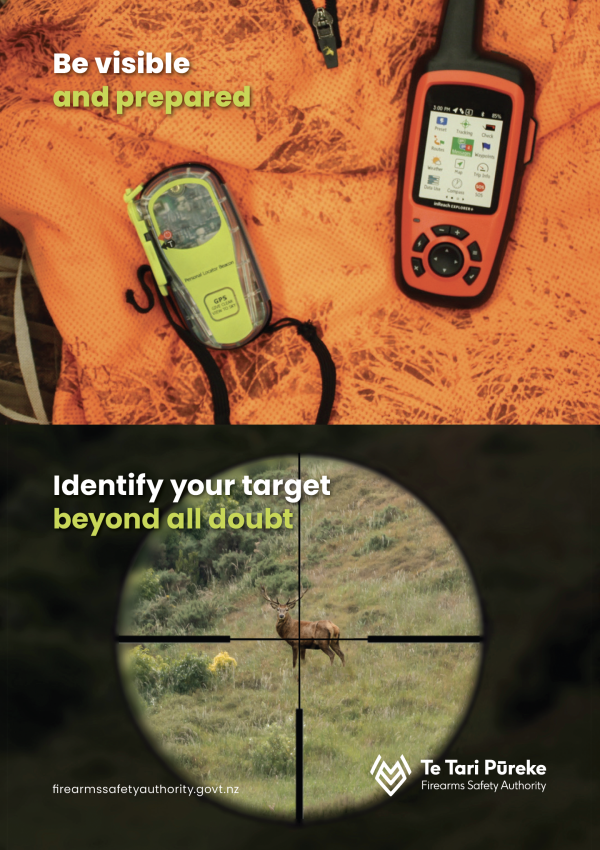
Rule 5: Check your firing zone
- Be aware of anything that may be in the area between you and your target, and in the area beyond your target.
- Before you shoot, ask yourself: “What could happen if I miss my target?”
- Never shoot at something on the skyline.
- Be extra careful around rivers, as hard, flat surfaces, including stones or water, may cause a ricochet.
- If you can’t 100% ensure your firing zone is safe – do not fire.
When hunting with others:
- Never fire when companions are ahead of you, especially when you have lost sight of them.
- Have an agreed plan with all members of the group (plan the hunt, hunt the plan).
- If you lose sight of each other, or if unsure of your actual location, stop hunting until contact or position has been re-established.
- Your firing zone is constantly changing, especially when following a moving target.
- Use radios to communicate with other members of your group.
- Know the boundaries of your party’s designated hunting area. Use technology to assist with keeping track of your position.
Night shooting
- Do not use a night vision device mounted on a firearm for general observation. Doing this breaks Rule 2 – always point your firearm in a
- safe direction.
- Be aware of anything that may be in the area between you and your target, and in the area beyond your target.
- Never fire when companions are ahead of you, especially when you have lost sight of them.
- Before you shoot, ask yourself: “What could happen if I miss my target?”
- Never shoot at something on the skyline.
- It is an offence, under the Conservation Act, to shoot during the hours of darkness in any state forest, forest park or national park.
Maximum projectile
Maximum projectile range for projectiles your firearm may be as much as:
.22 Long Rifle: 2.5 kilometres
.308 calibre: 4.5 kilometres
Airgun: up to 400 metres
Shotgun: from 250 metres to 750 metres (depending on the type of cartridge)
Sights need to be set correctly to prevent rounds falling short or going far beyond the target.
Firing zones
Your firing zone changes rapidly when you follow a moving target with a firearm. As you swing the muzzle around in an arc be aware of the position of other hunters. Make sure they are not caught in the path between your firearm and the target, or beyond the target.
This is especially important when shooting with shotguns. Duck shooters sharing a maimai can drive vertical poles into the ground to prevent an ‘over- swing’ that may put others in danger.
Rule 6: Store and transport firearms and ammunition safely
A firearms licence holder in possession of a firearm is required by law to:
- ensure young children, or any people without a firearms licence, do not have ready access to firearms and ammunition; and
- ensure that any firearm in their possession is stored separately from any ammunition for the firearm so that a person who obtains access to the firearm cannot obtain access to the ammunition.
These steps must include locking every firearm that is on the holder’s premises and is not under the immediate and personal supervision of the holder or some other holder of a firearms licence in:
- a lockable safe, cabinet, container, or receptacle of stout construction (secured to the structure of the premises); or
- a lockable steel and concrete strongroom; or
- a lockable display cabinet or rack in which firearms are immobilised
Police may inspect your security arrangements, including the materials used, method of construction (including locks, doors and hinges) and how the storage rack, safe, box or cabinet is anchored to the premises/structure.
Ammunition must also be stored in a separate secure storage container (such as a cash box or an ammunition box that is in secure storage or in a stout locked cupboard) with a different key or combination lock to the container for your firearms.
Restricted weapons must be rendered inoperable by removing a vital part. It is best practice to store the removed vital part in a separate cupboard constructed to the same level of security.
A complete firearm is dangerous in the wrong hands, so lock away your unloaded and disabled firearm and ammunition separately when not in use. Do this immediately when you return to camp or home from shooting. Securing firearms out of sight will help prevent them being stolen.
Rule 7: Avoid alcohol or drugs when handling firearms
When handling a firearm, you must be able to think clearly. Alcohol and some drugs (even if prescribed) slow your mental and physical reactions.
Some prescription and over the counter medicines can affect your mental and physical reactions so read the label and seek medical advice. If the information on the medicine advises against driving or using machinery, do not handle firearms.
Alcohol and firearms never mix!
- Alcohol or drugs must never be taken just before you go shooting or while you are shooting.
- Wait until your firearm has been safely locked away before you drink alcohol or take drugs.
- Do not shoot with others who are, or have been, drinking alcohol or taking drugs.
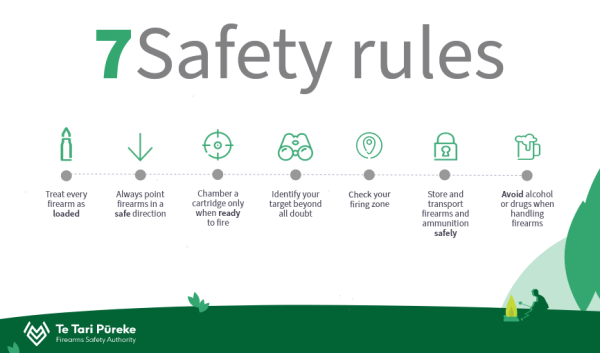
2022 Firearms Safety Code
There’s a new Firearms Safety Code available. If you’ve got a firearms licence, make sure you’re familiar with the new Code. https://www.firearmssafetyauthority.govt.nz/firearms-safety/firearms-safety-code

